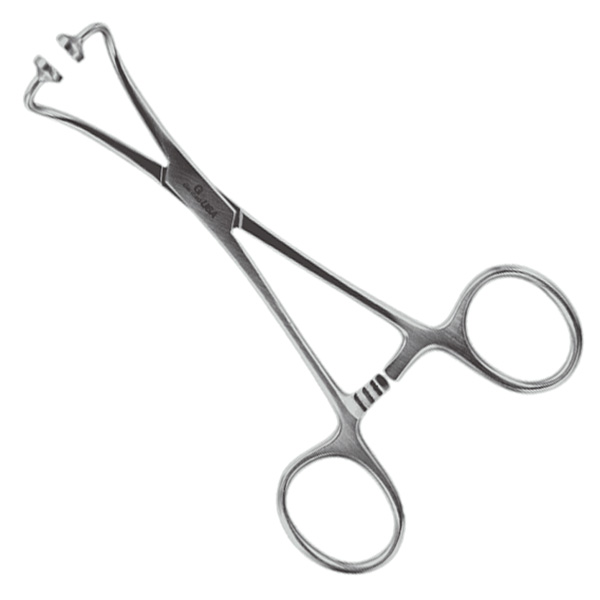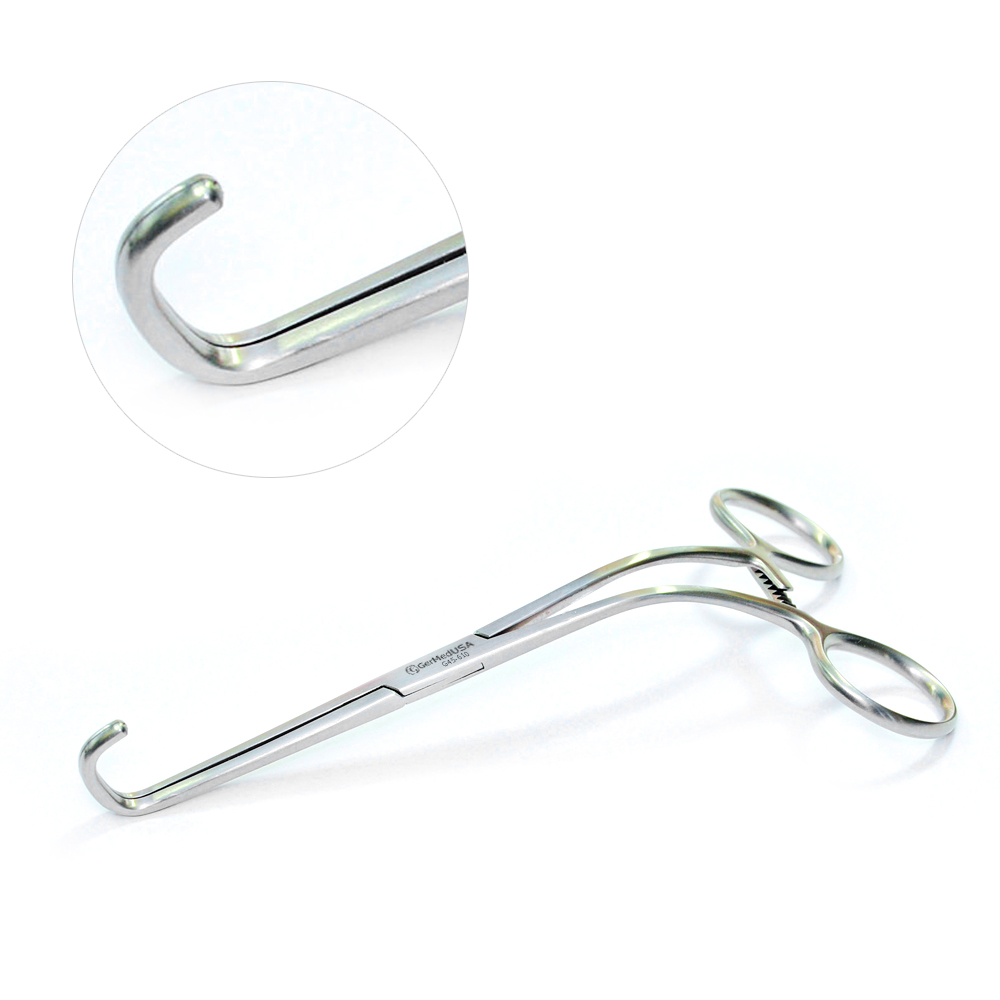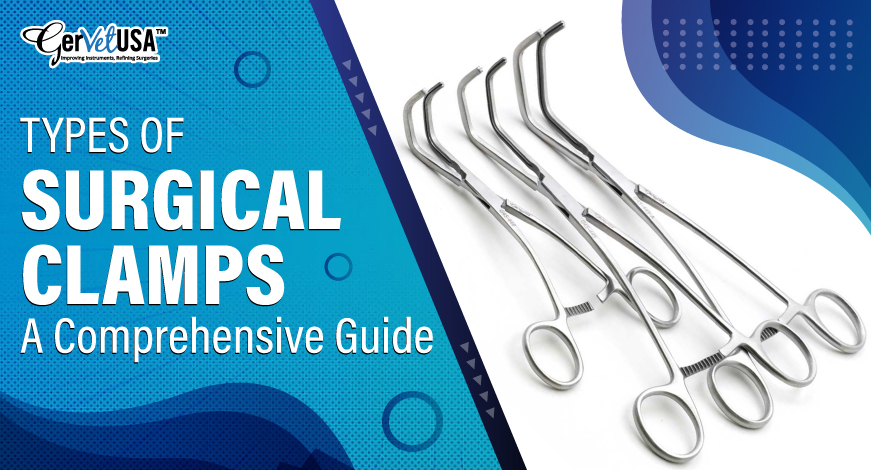Every day, countless surgeries are carried out around the world. All these essential operations have a common thing in using special tools. One of the most important of these is the surgical clamp. They play a chief role in the operating theatre, ensuring precision, safety, and cleanliness.
This blog will uncover the different types of surgical clamps, how they are used, and how they contribute to a successful operation.
We will discuss different types of veterinary clamps, including vascular clamps, orthopedic clamps, and towel clamps. Each clamp has its own characteristics and helps surgeons perform daily miracles in the surgery room.
Keep Reading!
Types Of Surgical Clamps
There are a variety of Veterinary Surgical Clamps; let’s discuss the most commonly used ones,
Veterinary Towel Clamps

while these types of surgical clamps might seem small, their importance in a surgical procedure is monumental. They provide the stability and sterility surgeons need and demonstrate the incredible power of this small tool in the operating room.
1. Jones Towel Clamps
Among surgical instruments, these types of surgical clamps stand out. Its design features sharp, pointed corners for a firm grip on towels and tissue.
Surgeons often use Jones clamps to secure tissue during surgery, but their primary function is to hold the surgical towel in place.
The clamps offer unprecedented surgical precision thanks to their firm yet soft grip.
2. Barkhaus Towel Clamps Veterinary
The Barkhaus towel clamps are a fundamental pillar in the operating theatre. It features a ratchet mechanism for securing towels and sheets.
The sharp, curved teeth can easily penetrate several layers of tissue without causing significant damage.
As a reliable assistant to the surgeon, backhaus veterinary towel clamps are essential in maintaining sterile conditions in the operating room.
3. Lorna Non-Perforated Towel Clamp
Sometimes, a gentler approach to clamping is required. These clamps are the ideal solution in such cases.
Unlike other clamps, the blunt head provides a gentler grip with less risk of tearing.
With these clamps, delicate materials remain in place without puncturing or tearing, thus preserving the integrity of the sterile area of the operating theatre.
4. Backhouse Towel Clamps Veterinary – Left Hand
Finally, like the right-handed surgeon veterinary clamps, these instruments are designed for left-handed surgeons.
It features sharp, curved teeth and a ratchet locking mechanism for left-handed surgeons.
This exclusive tool emphasizes the importance of considering the comfort and preferences of the healthcare professional, leading to more accurate and successful surgical procedures.
In summary, the four types of surgical towel clamps are briefly illustrated:
| Type of Towel Clamp | Key Features | Uses |
| Jones Towel Clamp | Sharp points, ratcheted closure | Securing surgical drapes |
| Backhaus Towel Clamps | Sharp, curved prongs, ratcheted design | Maintaining a sterile field during operations |
| Lorna Non-Perforated Towel Clamp | Gentle, rounded ends, non-penetrating design | Ideal for minimizing tissue trauma |
| Backhaus Towel Clamps - Left Hand | Mirror design for left-handed use | Ensuring a sterile field for left-handed practitioners |
Remember, it is always important to recognize the contribution these medical instruments make to the success of a surgical procedure.
Orthopedic Clamps
They are wonderful tools that perform various functions, such as fixing bone fragments and helping to heal fractures in orthopedic surgery.
Let's take a closer look at five different types of orthopedic/bone clamps:
1. Lowman Bone Holding Clamp
These specialized types of surgical clamps are essential during orthopedic surgery, primarily for fixing bones and bone fragments.
The unique construction of the Roman bone fixation clamps, with two points on one end and one on the other, allows for a secure grip on the bone.
2. Bone Holding Clamp 6" With Measuring Caliper
This multifunctional instrument combines the functions of a bone clamp and a measuring caliper.
The clamps hold the bone fragment firmly during surgery, and the built-in thickness gauge provides accurate measurements for precise surgery.
3. Lambert Lowman Bone Clamp
The Lambert-Roman bone clamps are a variant of the Roman bone clamps.
This instrument has a larger clamping surface and is ideal for extensive bone procedures or when a stronger grip is needed.
4. Ikuta Bone Clamp
Named after its inventor, the Ikuta bone clamps are designed to provide a firm, non-slip grip on bone during surgery.
Their innovative design minimizes injury to the bone and speeds recovery.
5. Medial Malleolar/Bone Fragment Clamps
Specially designed to secure small bone fragments, these types of surgical clamps provide precise control and a secure grip, making them an essential tool for surgeons performing delicate ankle and other minor bone surgeries.
These clamps are not only useful during surgery, but they also indirectly influence patient recovery and overall outcome.
By ensuring stability, measurement accuracy, and damage reduction, these tools contribute to safer surgery and better outcomes.
| Type of Clamp | Key Features | Uses |
| Lowman Bone Holding Clamp | Unique two-pronged and single-pronged ends | Securely holding bones or bone fragments during surgery. |
| Bone Holding Clamp 6" With Measuring Caliper | Combines clamp and caliper | Holding bones and providing accurate measurements |
| Lambert Lowman Bone Clamp | Larger clamping area | Ideal for larger bones or where a stronger grip is required |
| Ikuta Bone Clamp | Non-slip design, minimal bone trauma | Firmly holding bones during surgery leads to faster recovery. |
| Medial Malleolar/Bone Fragment Clamps | Precise control and secure grip | For securing small bone fragments, ideal for delicate operations |
These are just some bone clamp types used in orthopedic surgery. Understanding their differences helps us appreciate the complex blend of science and innovation used for a successful surgery.
Vascular Clamps
These types of surgical clamps veterinary are used as multi-purpose clamps and a versatile addition to the surgical toolbox.
In general, these clamps play an essential role in vascular surgery. Their design enables them to meet different surgical requirements and patient needs, making surgery safer and more efficient.
1. Satinsky Vascular Clamp for Vena Cava
Starting, we introduce the Satinsky Vascular Clamp for the Vena Cava. This unique instrument design enables strong, safe, and gentle clamping.
Its purpose is to control blood flow during complex procedures in the inferior vena cava (the central vein through which deoxygenated blood enters the heart).
2. Satinsky Vascular Clamp CTI
This instrument has similar features to the inferior vena cava clamp but has been specially designed to facilitate cardiac and thoracic surgery.
These types of surgical clamp offer a good balance between precision and safety and is highly appreciated in the operating room.
3. Debakey Vascular Clamp
Named after legendary cardiac surgeon Michael Debakey, this clamp is uniquely designed to ensure meticulous control during vascular surgery.
Debakey clamps are renowned for their low trauma and are commonly used in cardiovascular surgery.
4. Stille Pattern Vessel Clamp
Finally, let's introduce the Stille Pattern Vessel Clamp. A reliable tool for a wide range of surgical procedures, these fine-toothed clamps enable precise clamping.
| Type of Clamp | Key Features | Uses |
| Satinsky Vascular Clamp for Vena Cava | Firm, secure clamping; gentle on tissue | Used in surgeries involving the vena cava |
| Satinsky Vascular Clamp CTI | Precise, safe clamping | Used primarily in cardiothoracic interventions |
| Debakey Vascular Clamp | Meticulous control; less traumatic clamping | Widely used in cardiovascular procedures. |
| Stille Pattern Vessel Clamp | Finely toothed jaws; Versatile | Used for general-purpose clamping in various surgeries |
Remember that the world of medicine is vast and constantly evolving. Each tool we've discussed plays an essential role in the bigger picture. Stay tuned for more exciting research!
Specialized Surgical Clamps
Specialized surgical clamps are no ordinary clamps. Each has a specific use in a different surgical procedure.

1. Soft Palate Clamps
First, let's introduce the soft palate clamps. As the name suggests, this unique tool is ideal for soft palate surgery.
It is designed for gentle, secure clamping to ensure a smooth surgical procedure.
2. Ligament Meniscus Clamp
The following instrument is the meniscal ligament clamps. These types of surgical clamps have a firm grip and are specially designed for delicate tissues such as the meniscus during knee surgery.
It gives the surgeon the necessary control during a complex operation.
3. Tonsillectomy Clamp
Let's move on to the tonsillectomy clamps. Tonsillectomy clamps are used to manipulate and gently remove the tonsils—an indispensable tool for ENT surgeons worldwide.
4. Dr. Titolo Declaw Clamp
Dr. Titolo Declaw is an indispensable tool for veterinary surgeons.
These special clamps enable safe, humane claw removal during feline nail removal.
5. Huston Umbilical Clamp
Next, let's take a look at the Houston Cord Clamps. These clamps help clinicians manage the umbilical cord stump after birth and promote hygiene and safety in neonatal care.
6. Sesamoidectomy Clamp
The sesamoidectomy clamps are a practical tool for foot surgery. It is specially designed for precise control when removing the sesamoid bone, ensuring optimal results in foot surgery.
7. Martin Cartilage Clamp
Finally, we have the Martin cartilage clamps. These clamps are designed to manipulate cartilage during various orthopedic procedures safely.
These types of surgical clamps are indispensable tools in the orthopedic toolbox.
| Type of Surgical Clamp | Key Features | Uses |
| Soft Palate Clamp | Gentle, secure clamping | Used in surgeries involving the soft palate |
| Ligament Meniscus Clamp | Firm grip for delicate tissues | Used in knee surgeries involving the meniscus |
| Tonsillectomy Clamp | Designed for careful handling | Used in tonsillectomies |
| Dr. Titolo Declaw Clamp | Specific to veterinary surgeries | Used in declawing procedures in cats |
| Huston Umbilical Clamp | Ensures hygiene and safety | Used in neonatal care after childbirth |
| Sesamoidectomy Clamp | Precise control | Used in foot surgeries involving the sesamoid bone |
| Martin Cartilage Clamp | Safe handling of cartilage | Used in various orthopedic surgeries |
To Sum Up
Familiarizing ourselves with the world of different types of surgical clamps can seem daunting. From clamps used to stop bleeding to Satinsky clamps, essential for major organ operations, each clamp plays a crucial role in the success of a surgical procedure. By understanding their functions, we can better appreciate the complexity of surgical procedures and the tools they enable. But remember, this guide is just the tip of the iceberg. There's always more to learn in the exciting world of medical technology.
Are you now looking for tools of unrivaled quality? GerVetUSA's multiple types of surgical clamps feature unbeatable precision, durable materials, and ergonomic design to ensure a comfortable and efficient surgical procedure. All our veterinary clamps are easy to clean and sterilize and meet the most stringent safety standards.
FAQs
Are GerVetUSA’s different types of surgical clamps suitable for all types of surgery?
Absolutely! We offer a range of veterinary clamps for different surgical needs. Whether you're performing minor or complex surgery, GerVetUSA will take care of you.
Are surgical clamps sterilized after each use?
Yes, surgical clamps, like all reusable surgical instruments, are carefully sterilized after each use to ensure their safety for the next procedure. This is generally done by a process known as autoclaving.
What's the difference between surgical clamps and surgical forceps?
The main difference lies in their purpose. Clamps are generally used to control the flow of fluids or to hold the tissue in place, whereas forceps are used to manipulate tissue directly. However, in some contexts, these terms can be used interchangeably.







